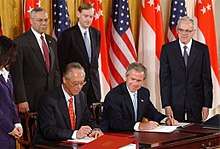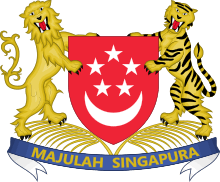Singapore–United States relations
 | |
Singapore |
United States |
|---|---|
United States – Singapore relations are bilateral relations between the United States and Singapore. Singapore and the United States share a very close and excellent relationship. According to the U.S. Global Leadership Report, 77% of Singaporeans approved of U.S. leadership under the Obama Administration in 2010, and while this approval rating decreased slightly down to 75% in 2011, it nonetheless remains one of the highest ratings of the U.S. for any surveyed country in the Asia-Pacific region.[1]
History
The United States first opened a consulate in Singapore in 1836, when the island was part of the Straits Settlements of the British Empire. Singapore and the United States have maintained formal diplomatic relations since the independence of Singapore in 1965.[2] Singapore's efforts to maintain economic growth and political stability and its support for regional cooperation harmonize with U.S. policy in the region and form a solid basis for amicable relations between the two countries.[3]
Hendrickson affair
Lee Hsien Loong, Prime Minister of Singapore, in a 2008 speech to the Internal Security Department on the occasion of their 60th anniversary dinner.[4]
E. Mason "Hank" Hendrickson (born 1945), an American diplomat married to fellow Foreign Service officer Anne E. Derse, was serving as the First Secretary of the United States Embassy when he was expelled by the Singaporean government in May 1988.[5][6][7] Prior to his expulsion, he arranged for Francis Seow and Patrick Seong to travel to Washington, D.C. to meet with American officials at Hendrickson's arrangement.[8] After their return, Singapore detained them under the Internal Security Act.[9] Based on Seow and Seong's statements while in custody, the Singaporean government alleged that Hendrickson attempted to interfere in Singapore's internal affairs by cultivating opposition figures in a "Marxist conspiracy".[8] Then-First Deputy Prime Minister Goh Chok Tong claimed that Hendrickson's alleged conspiracy could have resulted in the election of 20 or 30 opposition politicians to Parliament, which in his words could lead to "horrendous" effects, possibly even the paralysis and fall of the Singaporean government.[9]
In the aftermath of Hendrickson's expulsion, the U.S. State Department praised his performance in Singapore and denied any impropriety in his actions.[5] The State Department also expelled Robert Chua, a senior-level Singaporean diplomat equal in rank to Mason, from Washington, D.C. in response.[10][11] The State Department's refusal to reprimand Hendrickson, along with their expulsion of the Singaporean diplomat, sparked a protest in Singapore by the National Trades Union Congress; they drove buses around the U.S. embassy, held a rally attended by four thousand workers, and issued a statement deriding the U.S. as "sneaky, arrogant, and untrustworthy".[12]
A Heritage Foundation paper speculated that Singapore's angry public reaction to the Hendrickson affair may have been a response to the January 1988 termination of Singapore's eligibility for the Generalized System of Preferences, which provided tariff exemptions on Singaporean exports to the United States.[10]
2018 North Korea-US Summit
The latest meeting was held on 11 June 2018 between Prime Minister Lee Hsien Loong and President Donald Trump at the Istana before meeting Kim Jong Un the next day.[13]
Fields of relations
During the Asean Summit of 2015 when US President Barack Obama met Singapore Prime Minister Lee Hsien Loong, Obama described the state of bilateral relations as being "very, very strong".[14]
Free trade agreement

The United States and Singapore signed a bilateral free trade agreement on 6 May 2003; the agreement entered into force on 1 January 2004. The growth of U.S. investment in Singapore and the large number of Americans living there enhance opportunities for contact between Singapore and the United States. Singapore is a Visa Waiver Program country.[3]
Military relations
.jpg)
Singapore has long standing military relations with the United States. The United States sells arms to Singapore and provides access to its bases to train the Singaporean armed services outside of their small city-state.[15] Under the U.S.–Singapore Strategic Framework Agreement, some U.S. Navy littoral combat ships are rotationally deployed to Singapore's Changi Naval Base.[16] Air Force One also lands at Paya Lebar Air Base whenever the president visits the country.
Relief operations
Following that devastation of the United States Gulf Coast by Hurricane Katrina, three Singaporean CH-47 Chinook helicopters and thirty-eight RSAF personnel from a training detachment based in Grand Prairie, Texas, assisted in relief operations from 1 September. They ferried about 700 evacuees and hauled tons of supplies in 39 sorties on 4 September. One more CH-47 Chinook helicopter was sent to aid in relief efforts.
Academic exchanges
In 2011, more than 4,300 Singaporeans were studying in the United States, the highest figure in 10 years. The number of Singaporean students studying in the United States grew by 7 percent since 2010. American universities with the most number of Singaporeans are among the most prestigious in the country which includes Harvard University, Cornell University, Stanford University, and University of California, Berkeley. To add to the rising number of college students study in the United States, many local students in Singapore have also opted to study in American High Schools. US Ambassador to Singapore David Adelman said that the high number of Singaporeans studying in the United States reflects that Singapore–United States relations "have never been better".[17]
In 2012, Singapore and the United States signed a Memorandum of Understanding (MOU) to enhance collaboration in education between the two countries. This is the second MOU between the United States and Singapore on education. The first MOU signed in 2002 primarily focused on the teaching and learning of the Singaporean method of Mathematics and Science. The 2012 MOU have enhanced the teaching of Mathematics and Science, teacher development and school leadership, and educational research and benchmarking studies. In Addition, the conference also announced that the National Institute of Education (NIE) in Singapore and Columbia University's Teachers College are launching a joint Masters of Arts in Leadership and Educational Change. This joint Masters programme will take in up to 30 students from January 2013.[18]
The U.S. government sponsors visitors from Singapore each year under the International Visitor Leadership Program (IVLP). The U.S. Government provides Fulbright Awards to enable selected American professors to teach or conduct research at the National University of Singapore and the Institute of Southeast Asian Studies. It awards scholarships to outstanding Singaporean students for graduate studies at American universities and to American students to study in Singapore. The U.S. government also sponsors occasional cultural presentations in Singapore. The East-West Center and private American organizations, such as the Asia Foundation and Ford Foundation, also sponsor exchanges involving Singaporeans.[3]
Diplomatic representation
In addition to the Embassy of Singapore, Washington, D.C., Singapore has a Consulate General in San Francisco, a Consulate in New York (also as regional consular services for eastern Canada after closure of Consulate in Toronto) and Honorary Consulates in Chicago, Miami and Houston. The Singapore ambassador to the United States is Ashok Mirpuri.[19] Former United States Ambassador to Singapore. Steven J. Green is the Honorary Consul in Miami while the Former Chairman of the Federal Communications Commission, Newton N. Minow is the Honorary Consul in Chicago.
The United States first opened a consulate in Singapore, then part of the British Straits Settlements, in 1836, appointing Joseph Balestier to the post of consul. The American embassy in Singapore was established on 4 April 1966, under chargé d'affaires ad interim Richard H. Donald.[2] Kirk Wagar served as US Ambassador to Singapore from September 2013 to January 2017.[20][21] Former Deputy US National Security Adviser K. T. McFarland has reportedly been offered the ambassadorship to Singapore; the position requires confirmation by the US Senate.[22]
See also
Notes
![]()
- ↑ U.S. Global Leadership Project Report - 2011 Gallup
- 1 2 U.S. State Dept. 2011
- 1 2 3 U.S. State Dept. 2009
- ↑ Speech by Prime Minister Lee Hsien Loong at the Internal Security Department 60th Anniversary Dinner, Singapore: Prime Minister's Office, 2008-08-30, archived from the original on 2008-09-22, retrieved 2010-03-03
- 1 2 Crossette, Barbara (1988-05-08), "Singapore Asks Removal of U.S. Envoy", The New York Times, retrieved 2010-03-03
- ↑ Rogers 2002, p. 131
- ↑ American Ambassador to Azerbaijan Anne E. Derse, USAID, 2007-07-06, archived from the original on 2009-05-17, retrieved 2010-03-03
- 1 2 Bellows 1989
- 1 2 "Hendrickson affair angers local leaders", New Sunday Times, 1988-05-10, retrieved 2010-03-11
- 1 2 Conboy 1989
- ↑ "What Lee said in 1964", The Economist, 1988-05-14, retrieved 2011-03-17
- ↑ "Singapore: Thousands Protest Expulsion", Eugene Register Guard, 1988-05-12, retrieved 2010-03-03
- ↑ https://www.channelnewsasia.com/news/singapore/pm-lee-meets-us-president-donald-trump-ahead-of-trump-kim-summit-10418832
- ↑ "The Straits Times - Singapore-US ties 'very, very strong': Obama". Government of Singapore. Archived from the original on 26 November 2015. Retrieved 25 November 2015.
- ↑ Brabenec, James (2010-11-24), "Singaporeans get HIMARS qualified.", GlobalSecurity.org, retrieved 2011-03-17
- ↑ Tomkins, Damien (8 June 2011), "US Reaffirms Asia Role", The Diplomat, retrieved 2011-09-05
- ↑ "Singaporean student numbers at US varsities hit 10-year high". Retrieved 11 February 2012.
- ↑ "Channel Newsasia". Retrieved 11 February 2012.
- ↑ Ambassador CHAN Heng Chee, Washington, D.C.: Singapore Embassy, archived from the original on 2010-01-08, retrieved 2010-03-12
- ↑ Kirk Wagar, archived from the original on 2016-12-20, retrieved 2016-12-16
- ↑ Bittersweet farewell for US ambassador to Singapore Kirk Wagar, hours before Trump's inauguration. MSN. 2017-01-20. Retrieved 2017-04-10.
- ↑ McFarland reportedly offered Singapore ambassador post. The Hill. 2017-04-01. Retrieved 2014-04-10.
Further reading
- Bellows, Thomas J. (February 1989), "Singapore in 1988: The Transition Moves Forward", Asian Survey, 29 (2): 145–153, doi:10.1525/as.1989.29.2.01p0242q, JSTOR 2644574
- Chua, Daniel Wei Boon, "Becoming a `Good Nixon Doctrine Country': Political Relations between the United States and Singapore during the Nixon Presidency," Australian Journal of Politics and History 60 (Dec. 2014), 534-48.
- Conboy, Kenneth J. (January 1989), "Opportunities for Bush to Bolster the U.S.-Singapore Relationship" (PDF), Asian Studies Backgrounder, 86, retrieved 2010-03-03
- Background Note: Singapore, Bureau of East Asian and Pacific Affairs, Department of State, September 2009, retrieved 2010-03-11
- "Singapore", A guide to the United States' history of recognition, diplomatic, and consular relations, by country, since 1776, Office of the Historian, U.S. Department of State, 2011, retrieved 2011-09-05
External links
![]()
